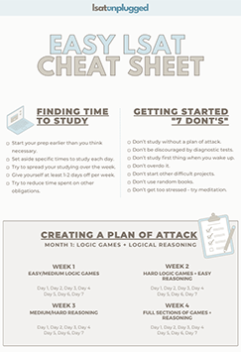LSAC loves In-Out Games where all the rules can be connected. It’s not hard to understand why. They require a solid understanding of conditional reasoning and indicator words.
Despite the fact that In-Out games with similar rules have been administered several times in the past, people still have trouble with them.
I’ve never diagrammed an In-Out game of this type on the blog – it’s time I did.
Birds in the Forest – PrepTest 33, Game 2 (p177 in Next 10)
We know this is an In-Out game because we want “to see which of the following…it contains.” In any given scenario, the birds that it contains are “In,” and the birds that it does not contain are “Out.”
We can connect the rules to form two long chains (which are the contrapositives of each other). We do this by looking for cases where the necessary condition of one rule and the sufficient condition of another are identical. If they are the same, we can link them.
For example, suppose we’re given the rules:
If X -> Y
If Y -> Z
In this case, Y is necessary in the first rule and sufficient in the second.
This means we can form the chain X -> Y -> Z.
Now that we have that out of the way, let’s go look at the Birds in the Forest game:
First rule:
If H is in, then G is not.
H –> NOT G
I diagram this as:

Contrapositive:
If G is in, then H is not.
G –> NOT H.
Second rule:
If J, M, or both are in, then so is H. The both part is redundant, so we can just say that either one is sufficient to bring about H.
This means that if H is out, then both J and M must have been out.
I immediately connect this rule (and its contrapositive) with what I’ve written down for the first rule (and its contrapositive).
We now have:
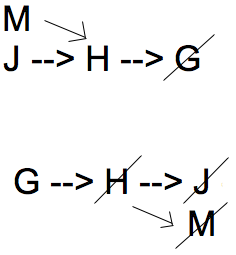
Third rule:
If W is in, then G is in.
Contrapositive:
If G is out, then W must be out.
Connecting this to what we already have, it becomes:
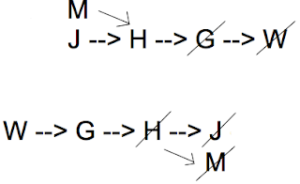
Fourth rule:
If J is out, then S must be in.
Contrapositive:
If S is out, then J must be in.
Connecting these to what we already have, it becomes:
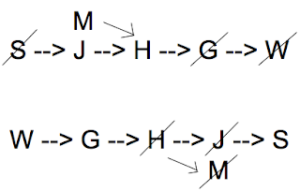
Now we have every rule connected in one big chain – in both the original form of each rule, and its contrapositive. I simply connected each new rule (and its contrapositive) with a previous rule (or its contrapositive) as I read it.
With this big conditional chain, we know that when W is in, both G and S are in, and H, J, and M will be out.
When S is out, both J and H are in, and G and W are out. However, we don’t know where M is.
On the chain, proximity/closeness doesn’t matter.
Anytime we have a positive variable followed by a negative variable, at least one of those two variables is out. (Maybe both are out.) We don’t care whether the negative is immediately after the positive or several variables later.
Anytime we have a negative variable followed by a positive variable, at least one of those two variables is in. (Maybe both are in.) We don’t care whether the positive is immediately after the negative or several variables later.
The final question of this game requires a new rule (and its contrapositive) to be added to the diagram. On the diagram, it would look like the following:
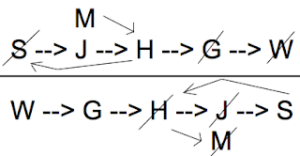
Since this is the last question of the game anyway, and assuming you’ve answered all the others, it’s okay to modify the main diagram since you won’t be using it for anything else. Whenever a Logic Game requires a new rule to be added, taken away, or substituted for an old rule, it’ll be in the last question of the game.
Why the technique here is better than other techniques:
Some companies recommend listing all the rules in their original form, then writing the contrapositive, then looking for connections. Other methods just fail to adequately represent all the inferences. Either way, they take up a lot of space and time.
Both methods require writing out all the rules and then looking for connections. This leads to a moment of panic when you’re not confident whether you’ve made all your inferences or not. You’re never confident that you’ve done everything.
The method I’ve laid out above does not require any extra writing, which saves space and time. As long as you can do the contrapositive, you can do this. Just remember that you can only follow an arrow in the direction it points.
A hint for those having trouble:
The chain perfectly represents the relationships between the variables. All the information from the rules already appears on the chain.
A sufficient condition appears to the left of a given arrow, and a necessary condition appears to the right of that arrow.
Just follow the arrows in the direction they’re pointing in, and you’ll be fine.
The difficulty that many of you have with these conditional chains is you’re trying to read them backward, which is not “permitted” in logic. Be careful not to confuse necessary and sufficient conditions.

